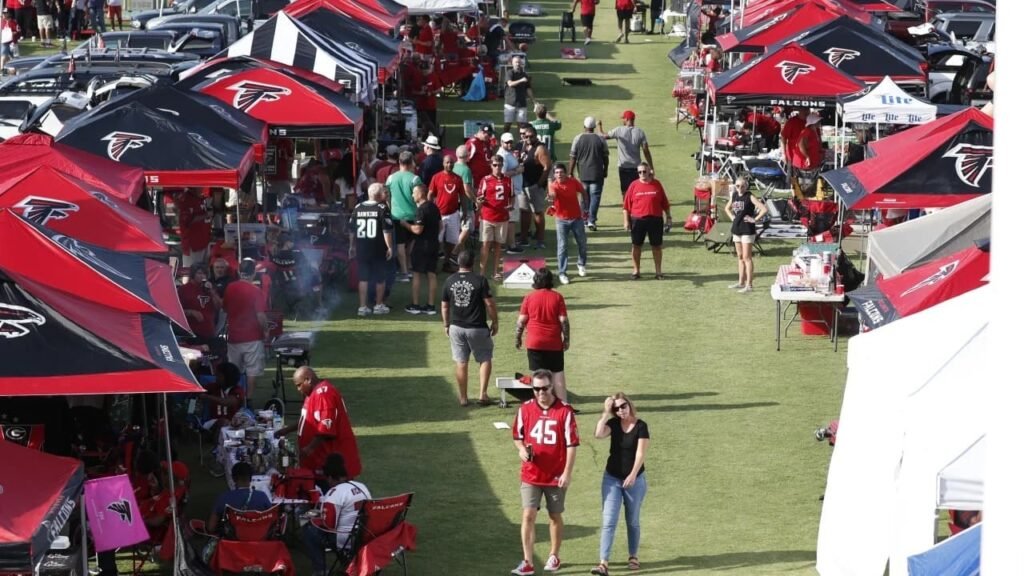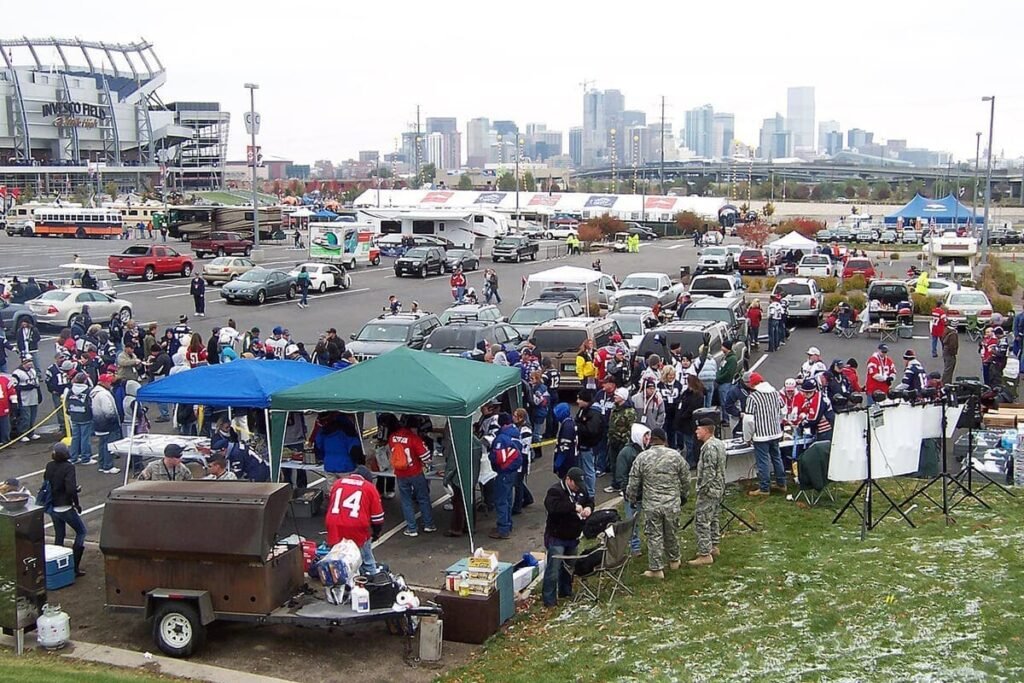This beloved American pastime is far more than a simple pregame meal. It is a deeply rooted cultural phenomenon. These vibrant pregame festivities unite communities and express fierce team loyalty.
Dr. Tonya Williams Bradford, a marketing professor at UC Irvine, studied this fan culture. Her research connects modern parking lot parties to ancient harvest celebrations. The practice has a rich history spanning over 150 years in the United States.
This article explores the evolution of these game-day rituals. We will trace its journey from simple beginnings to today’s elaborate communal gatherings. Discover how this essential part of the football experience became a defining tradition for millions of fans.
Historical Roots and Early Traditions of Tailgating
Long before parking lots filled with grills and team colors, the concept of gathering around food for entertainment had ancient beginnings. These early festive gatherings before winter established patterns that would evolve over time.
The Ancient Customs: Greek and Roman Festivities
Dr. Bradford’s research reveals how Greek and Roman harvest celebrations featured music and abundant provisions. Communities came together for communal feasting as winter approached.
When entertainment contests emerged, food naturally became part of the experience. This way of combining meals with spectator events created lasting social bonds.
The Civil War Picnic Battle at Bull Run
The first documented American-style gathering occurred during the civil war. On July 21, 1861, Washington residents traveled to the First Battle of Bull Run.
They packed elaborate picnic baskets for the seven-hour journey. Captain John Tidball described a “throng of sightseers” with carts full of pies.
These battlefield observers used opera glasses to watch the action miles away. The event earned the nickname “picnic battle” for its carnival-like atmosphere.
Future vice president Henry Wilson even distributed sandwiches to retreating soldiers. This early American history shows how people transformed practical meal planning into social celebration.
Evolution from Picnic Gatherings to College Football Rituals
Collegiate football’s emergence in the late 1860s transformed how Americans celebrated sporting events. The connection between food and spectating became firmly established during early university competitions.
From Carriages to College Campuses
Just eight years after the Civil War spectacle, Rutgers and Princeton faced off in the first recorded American football game in 1869. Supporters brought provisions to this historic contest on College Avenue, creating the foundation for campus traditions.

By the 1880s, elite college football culture featured well-heeled spectators enjoying champagne from horse-drawn coaches. These sideline gatherings during prestigious Thanksgiving matchups reflected the social status of early fans.
Wealthy alumni from dominant programs like Princeton, Yale, and Harvard could afford elaborate pregame experiences. Their affluence shaped the exclusive nature of early intercollegiate contests.
The pivotal year of 1906 marked a significant transition in collegiate athletics. Automobile registrations surpassed 100,000 as 32,000 supporters descended on New Haven for the Harvard-Yale game.
The New York Times described fields “simply black with machines parked together in such a hopeless mass.” This visual captured the new logistical challenges created by motorized vehicles replacing horse-drawn transportation.
Train passengers gazed with envious eyes at automobilists enjoying tempting viands from picnic hampers. This class dynamic highlighted how early tailgating reflected economic disparities among student supporters.
The combination of football’s growing popularity and increased automobile ownership created perfect conditions for the ritual’s evolution. Portable food solutions became necessary as teams attracted supporters from wider geographic areas.
Where Was Tailgating Invented: Exploring Its American Heritage
Rather than having a definitive birthplace, tailgating represents an organic evolution that unfolded across multiple American regions as key elements converged. This cultural phenomenon emerged as a uniquely American innovation born from the simultaneous rise of automobiles and organized sports.
The Role of Early Sporting Events and First College Games
The 1920s marked a critical decade for this sporting heritage. Automobile ownership surged alongside college football’s explosive popularity. Fans could now travel from wider geographic areas to attend games.
Colleges responded by constructing massive stadiums holding tens of thousands of supporters. Local restaurants struggled to feed these enormous crowds, leading to the rise of “trunk picnics” and “blanket dining” in parking lots.
The 1930s introduced wooden-sided station wagons with fold-down rear gates. These natural buffet tables gave the practice its enduring name. While some credit Yale’s Charley Loftus with coining the term, the word likely emerged organically from common usage.
This fan tradition represents a democratic social practice that distinguished American game-day customs from European sports traditions. The concept of pre-game partying became an essential part of the football experience across the nation.
The Automobile Revolution and the Rise of Parking Lot Parties
Automotive innovation transformed stadium parking areas into vibrant social hubs for pre-game celebrations. The transportation evolution created perfect conditions for elaborate fan gatherings. Parking lots became temporary communities where fans could enjoy extended festivities.

Station Wagons, Car Trunks, and Portable Grills
Wooden-sided station wagons with fold-down tailgates revolutionized fan experiences. These vehicles provided natural buffet tables for food preparation. The mass production of consumer technology made outdoor cooking accessible to everyone.
Portable charcoal grills and plastic coolers became essential equipment. Car trunks evolved into mobile kitchens with impressive storage capacity. This consumer technology democratized the pre-game ritual across social classes.
Transitioning from Horse-Drawn Coaches to Modern RV Setups
Recreational vehicles represent the latest chapter in this evolution. Modern RVs feature full kitchens and generator-powered entertainment systems. Portable generators now fit compactly in small cars instead of requiring heavy equipment.
Fans can power refrigeration systems and large-screen televisions for hours. The progression from basic trunk storage to sophisticated mobile living spaces shows continuous adaptation. Each generation incorporates new innovations while preserving core traditions.
Modern Tailgating Culture: Community, Food, and Game-Day Experiences
Today’s parking lot celebrations represent the pinnacle of fan culture evolution. These elaborate pregame festivities create temporary communities where team spirit flourishes. Dr. Bradford’s research shows participants believe their presence gives vital “mojo” to their home team.
Iconic destinations like Florida vs. Georgia’s “World’s Largest Outdoor Cocktail Party” showcase generations-old traditions. At Mississippi’s The Grove, elegant setups under ancient oak trees demonstrate sophisticated culinary traditions. These locations represent the ultimate fan engagement experience.
Innovations in Tailgate Technology and Setup
Modern technology has revolutionized the game-day atmosphere. Portable generators power multiple big-screen televisions in luxury RVs. Advanced cooling systems and wireless streaming extend the celebration for hours.
Compact equipment allows impressive mobile kitchens in standard SUVs. These innovations enable more elaborate social rituals while maintaining core traditions. The experience now incorporates digital connectivity with historical communal bonding.
Essential Tips for a Successful Tailgate
Preparation ensures an optimal game day experience. Always check weather forecasts and pack appropriate gear. Coordinate food with fellow attendees while bringing extra portions.
Familiarize yourself with specific stadium rules about grills and activities. Create comprehensive checklists covering cooking equipment and outdoor games. These practical steps guarantee smooth pregame festivities for everyone involved.
The modern tradition continues evolving while honoring its rich history. This cultural phenomenon represents unmatched brand loyalty and community connection.
Conclusion
What began as simple community meals before spectator events has transformed into a complex cultural phenomenon. This enduring tradition connects ancient Greek harvest festivals to Civil War picnics and modern parking lot parties. The evolution spans more than 150 years, showing remarkable continuity across time.
The practice represents a true American pastime that democratized fan experiences. It evolved from elite carriage gatherings to accessible parking lot celebrations. Core elements like shared food and team loyalty remain constant despite technological changes.
This cultural legacy demonstrates profound fan dedication and community building. The journey from ancient roots to modern practice reveals the evolution of fan culture. Tailgating stands as a powerful communal celebration that strengthens team identity across generations.
FAQ
What are the earliest known origins of the tailgating concept?
Did the Civil War really play a role in the history of tailgating?
How did college football help popularize this game-day ritual?
How did the automobile change the tailgating experience?
What are some essential items for a successful tailgate party today?
How has modern technology influenced tailgate culture?
Robson Calefi is a Data Processing Technologist and seasoned Web Developer who has been active in the digital industry since 1997. A passionate fan of the NFL and NCAA College Football, he founded AmericaTailgating.com in 2025 to share his love for the tailgating lifestyle.





